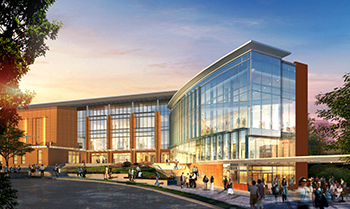Educational Heritage Shines in New Student Center
 RALEIGH, N.C. — North Carolina State University (NC State) was founded in two areas of study: agricultural, earth-based sciences and technology-driven mechanical arts. To honor this twofold heritage, Duda|Paine Architects has designed a new student union that reflects the institution’s dual origins and provides a new cultural hub for students.
RALEIGH, N.C. — North Carolina State University (NC State) was founded in two areas of study: agricultural, earth-based sciences and technology-driven mechanical arts. To honor this twofold heritage, Duda|Paine Architects has designed a new student union that reflects the institution’s dual origins and provides a new cultural hub for students.
The Durham, N.C.-based firm won a university-hosted design competition with its inspiring design that merged NC State’s existing student union building with contemporary form. The design team, led by Associate Principal Jay Smith, AIA, LEED AP and Senior Associate Scott Shell, AIA, LEED AP, maintained much of the 1970s-era student union facility, while doubling its square footage. Upon completion, the new Talley Student Union will offer 283,000 square feet of student life space.
“We ultimately maintained a significant portion of the existing building’s structure by generating concepts that allowed the addition of space outside the building footprint and the renovation of spaces within,” Smith said. “The driving concept was to bring students and visitors into the building’s core — a four-story atrium that links the union’s major program spaces — where they experience its full volume.”
Increasing entry points was also a key goal for the new union, which will serve as a crucial campus connector. In planning for more student traffic, it became clear the ground-level loading dock adjacent to the original building entrance had to go. Instead, the Duda|Paine team developed a subterranean loading dock, a first for the university, that de-cluttered the primary entrance and increased safety for pedestrians. The move required a substantial amount of coordination and extensive early design and configuration to ensure operational functionality and safety, according to Shell.
“The placement of a loading dock has significant impact on how a building will be serviced and maintained,” Smith added. “By shifting the loading dock below grade, we freed space to enlarge the facility’s footprint and greatly expand areas for students and student services.”
The renovation also affected ongoing operations in areas such as the theatre and student bookstore. “Part of the design was to determine how best to maintain operations in some spaces during building construction,” Shell said. “A great deal of consideration went into phasing the building and sequencing the construction process to maintain necessary operations as long as possible.” The team planned two distinct construction phases, including the creation of a temporary bookstore at another location.
Upon completion, the bookstore will rejoin the main student union, which includes a renovated 800-seat auditorium and a new 1,200-person divisible ballroom, as well as double the original dining options and meeting spaces. A 50,000-gallon water collection cistern, rain gardens and reconfigured transportation areas will be integrated into the design, which targets LEED Silver certification.
The Talley Student Union’s modern approach is characterized by a soaring Technology Tower and high-performance glass and curtain wall systems, which reflect the university’s commitment to STEM (Science, Technology, Engineering, Mathematics) principles. The Technology Tower also serves as a key landmark for the building and the university. These exterior aesthetics echo the original design goal of bringing people into a central space and allowing them to experience the building both vertically and horizontally, according to Smith.
In contrast, the building’s opposite side was scaled down. With warm-colored construction materials such as horizontal terra cotta louvers, this area reflects the university’s foundation in earth-based sciences. These two spaces merge seamlessly within the atrium, which will be a hub of student life and feature a wood art installation of the school’s mascot.
“The two sides of the building come together in that central space, which serves as a physical and metaphorical bridge between the two foundational aspects of the university,” Smith said.
Additional firms contributing to the project include interior architect Cooper Carry, student life planner MHTN, MEP engineering firm Stanford White, structural engineering firm Stewart Inc., civil engineer Kimley-Horn & Associates, landscape architect ColeJenest & Stone, lighting designer Cline Bettridge Bernstein and construction manager Rodgers/Russell/Dayeco. The second and final phase of the project will be completed by early 2015.
